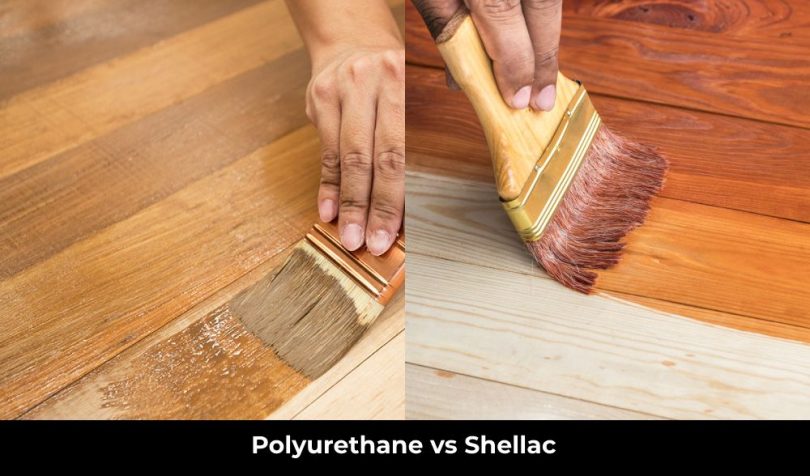Shellac is a good choice for decorative purposes where a glossy look is more important than durability, while polyurethane triumphs in protecting your furniture from damage.
When discussing polyurethane vs Shellac, you need to know more about their common use, color, sheen, ease of application, drying time, sanding, and durability.
Shellac
Shellac is widely used for cosmetics, coating chocolates, ice-cream cones, drugs, and dentistry purposes but it’s popular for producing a glossy sheen on furniture. They could be medium brown, yellow, blond, gold, amber, or orange in color.
You can use Shellac with a lint-free cloth, paintbrush, or sprayer, and within 30 – 60 min it will get dry and ready for another coating but it is not a durable coating for rough use furniture because humid weather, overheating, water or alcohol can damage it easily.
Pros
- Fast and easy to apply
- Dries so quickly
- Easy to repair and clean
- Environment-friendly
- The fragrance is good for inside drawers and cabinets
- Different colors to choose from
Cons
- Not so resistant as polyurethane
- Easily removable by water or alcohol
- After mixing with alcohol it’s shelf life only limited to six week
Polyurethane
There are two types: waterborne and oil-based. Both are good but oil-based polyurethane takes almost 24h to dry whereas waterborne requires only 2 – 6h. Naturally, polyurethane is clear in color but the oil one can have an amber tint.
Polyurethane produces lustrous, mid-gloss, satin, or matte sheen on wood and you can use it with cloth, paintbrush, foam brush, or sprayers. It is suitable for indoor and outdoor woodwork as it is effective against water and heat damage.
Pros
- Adds durability to floors or any structures
- Forms a hard-wearing film layer to protect the surface against abrasion water and moisture damage
- Better resistant to scratch, heat, water, and chemicals
- Available in a clear version
Cons
- Takes a long time to dry
- UV exposure gradually converts some polyurethane into amber.
Polyurethane vs Shellac: How They Compare
| Category | Polyurethane | Shellac |
| Origin | Synthetic | Lac bug |
| Types | Water & oil | N/A |
| Common use | Wood finish | Wood finish, coating food, and drugs |
| Colors | Clean and amber tint | Medium brown, yellow, blonde, gold, amber, and orange |
| Sheen | Lustrous, mid-gloss, satin, and matte | High gloss or semi-gloss |
| Ease of application | Cloth, paintbrush, foam brush, or sprayers | Lint-free cloth, paintbrush, or sprayers |
| Drying time | 2 hr for water & 24 hr for oil | 30 min |
| Sanding | Light sand with 220-320 grits before coating | Light sand with 220-320 grits before coating |
| Durability | High | Low |
1. Origin
Shellac originated from secretion by female “lac” bugs which is a natural bio-adhesive polymer. On the other hand, ultra-thin layers of various polyurethane are used for coatings, which are a synthetic liquid.
2. Common use
Polyurethane is frequently used as a long-lasting top coat on wooden floors, cabinets, regular-use furniture, and other wooden tops indoors as well as outdoors.
However, Shellac has wider applications in cosmetics, chocolates, and ice-cream cone coating and dentistry purposes but it is popular for its glossiest finish on decorative furniture.
3. Colors
Shellac is available in warmer (yellow, orange, gold), softer (blonde, amber) and muted (medium brown) sheds but polyurethane has clear color though oil-based polyurethane can have amber tint for its solvent.
4. Sheen
Shellac is popular for its high gloss sheen and mellow finish, which also highlights the wood’s natural look. Shellac finish looks attractive on walnut, mahogany, and fine veneer woods.
On the other hand, polyurethane finishes have various sheen levels: high-gloss, semi-gloss, satin and matte that makes it suitable for any woodwork.
5. Easy of application
Both wood finishers can be used with lint-free cloth, sprayer, or paintbrush but, you can also use a foam brush for polyurethane. Also, remember to use synthetic bristle brushes for waterborne polyurethane and natural-bristle brushes for oil-based.
6. Sanding
Sand between coats is important to improve the sticking of different layers for both shellac and polyurethane which also removes nibs and provides a clear finish. After drying each coat use 220 – 320 grits of light sanding for a smooth finish.
7. Drying time
Shellac only takes 30-60 min to dry one coating so you can complete your 3 – 4 coating under 6 hours. On the other hand, polyurethane drying time differs based on its types: waterborne drying time is 2 h but oil-based can take up to 24 h.
8. Durability
Since Shellac doesn’t last as long as Polyurethane, you can’t use it in humid weather because humidity will make it white or hazy. It may be easy to repair but frequent repair is necessary to keep it glossy, which means extra work from your end.
However, polyurethane is most durable for indoor and outdoor woodwork. It is effective at protecting furniture from water damage, heat damage, and scratches.
9. Easy to remove
You can remove shellac coating easily by using hot water or alcohol, if both of these fail to work, denatured alcohol will work for sure. On the other hand, to remove polyurethane you need to sand down the surface or you can use a polyurethane stripper to loosen the coating.
FAQs
1. Would it be a good idea to coat my front door in shellac?
Ans: If you have no problem with regular maintainance to keep your door glossy then it will be a nice idea but if you don’t then use a polyurethane coat.
2. Shellac vs polyurethane: Which coating should I use for my rooftop in winter?
Ans: Polyurethane roof coating lasts 10-20 years in wintry weather, but there are different choices for rooftops like Silicone coatings that are well known for UV and mositure protection.








